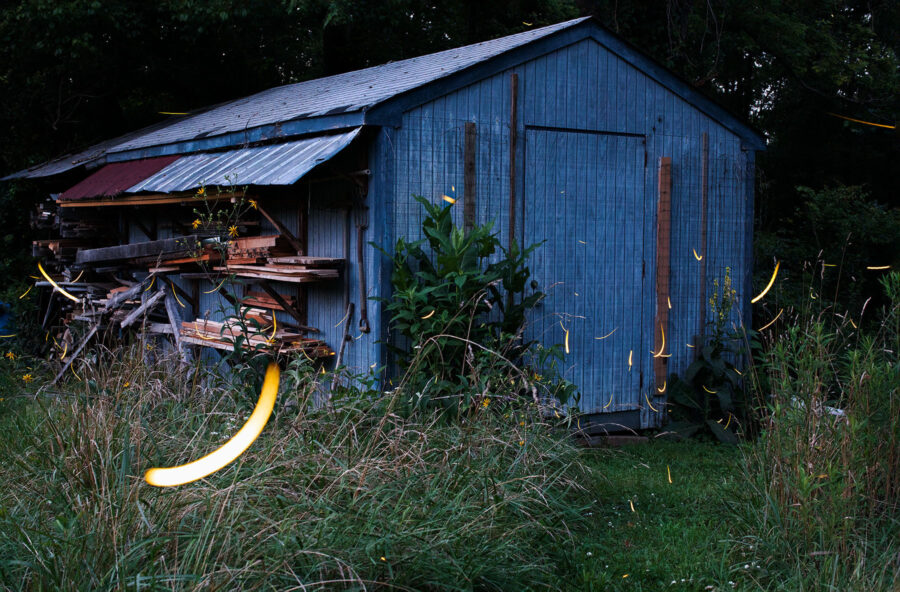Fireflies shed light on the benefits of a natural yard

As summer arrives, the symbol of changing seasons can be observed by specks of light illuminating parks and gardens. The arrival of the lightning bugs, or fireflies, is synonymous with summer nights in the eastern United States. Ironically, bugs are not the only living creatures compulsively attracted to bright lights. Fireflies naturally turn the attention of insect enthusiasts and everyday viewers alike.
Searching for light
On a warm evening in early July, I visited the property of Sam Droege, a biologist at the Patuxent Wildlife Research Center, to document the insect. His home in Laurel, Maryland, is adjacent to the Patuxent River, offering an ideal humid environment for fireflies. The damp habitat is a fertile environment for slugs, larvae and other insects that fireflies prey on. Droege also keeps his yard full of wild, native plants that serve as microhabitats for a variety of insects, making it an ideal viewing location.
“I like to think of my backyard as an extension of the parkland around it,” said Droege. “I have eliminated an acre of lawn and invasives, and in restitution have tried to convert much of the yard to native blooming plants.”
As the sun sets, the fireflies begin to come out: one, then two, until Droege’s garden becomes illuminated with the signaling of the ignited insect. Surrounded by vegetation and a swarm of fireflies, it’s easy to feel like you’re in a forest. While it’s uncommon to see “unkempt” yards like his, they are incredible habitats for a variety of wildlife pushed out by development and light pollution. The environment is also a great place to observe the behaviors of different firefly species, some of which prefer higher trees to lower vegetation.

Secrets of a famous bug
A common misunderstanding about fireflies is that they are not actually flies but beetles, nocturnal members of the family Lampyridae. The bioluminescent species catalyzes an enzyme, luciferase, through an oxidation reaction, emitting a warm glowing light meant to attract a mating partner—giving new meaning to the term “summer of love.” The males produce a flashing pattern that’s unique to their species to put on a show for the females. At times, some species may even synchronize their flashes. Droege pointed out a specific flight pattern that some species make, such as bobbing down and then up in a fixed spot before signaling.
Fireflies signal the effects of a changing climate
Although fireflies flash to serve a crucial biological purpose, they also are a telling signal of changes with the environment and climate. As summers become warmer, fireflies have been observed a week earlier than usual across the region. With a species so deeply connected to its habitat, its early arrival is a reminder of the importance of curbing climate change.
The best time to view them is from May through the end of June; however, as climates in the Northeast warm, the species can be found into July. Muggy weather right after rainstorms—though uncomfortable for some humans—is the ideal environment for prime firefly viewing.
Watching, chasing and catching fireflies is a beloved pastime in regions such as the Chesapeake. The fiery phenomenon is a reminder of how even the planet’s smallest creatures can bring tremendous joy and excitement to our lives. Consider making your yard more hospitable to all insects by planting native plants, minimizing light pollution, reducing herbicide use and allowing plants, grasses and other vegetation to grow for longer periods of time.

Comments
The article demonstrates that Sam Droege has such a broad knowledge of nature, which
continually amazes the rest of us mere mortals.
Our home in Herndon, VA (Fairfax County) backs to a wet wooded area, a designated conservation easement. In the 25 years we have lived here, we have never used pesticides. I have planted many native VA species. The result: we find worms in the soil wherever we dig. Best of all, The multiple lights of fireflies flying throughout our back yard brings us joy on hot summer nights after a rain storm.
Thank you for this article.
Great article and photos-we are lucky to have scientists like Sam around to keep us informed (and entertained!)-thanks-Lloyd
Thank you!
Your comment has been received. Before it can be published, the comment will be reviewed by our team to ensure it adheres with our rules of engagement.
Back to recent stories